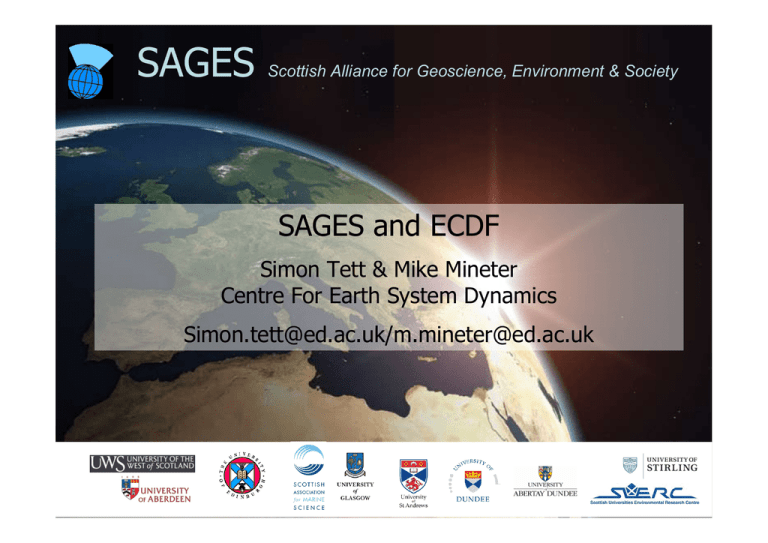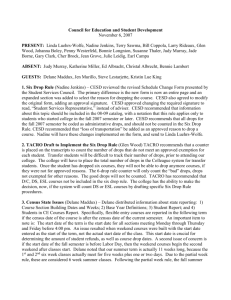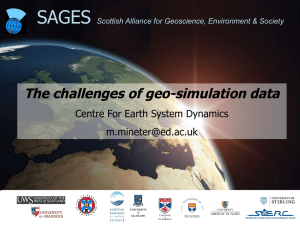SAGES SAGES and ECDF Simon Tett & Mike Mineter
advertisement

CESD
SAGES
Scottish Alliance for Geoscience, Environment & Society
SAGES and ECDF
Simon Tett & Mike Mineter
Centre For Earth System Dynamics
Simon.tett@ed.ac.uk/m.mineter@ed.ac.uk
1
Overview
CESD
• What, why, who of SAGES and CESD
• Initial steps
• Possibilities for the future
2
What is SAGES?
CESD
• Multi-institution, multi-disciplinary
collaboration at the forefront of earth and
environmental research.
• Goal: link discoveries in earth and
environmental science with the needs of
society.
– Pool expertise and resources
– Address complex issues outside individual
group’s scope
3
Centre for Earth System Dynamics:
What?
CESD
• “The modelling skills and range of
expertise in each Theme will be integrated
through the creation of a virtual centre for
Earth system dynamics”.
• CESD will:
– carry out modelling of the Earth System
– support research undertaken by SAGES
partners
4
Centre for Earth System Dynamics:
Who?
CESD
• CESD has to have defined membership,
not least because it is opening resources
and services to users in many institutions
• Who is in CESD?
– SAGES members, via a lightweight application
to CESD Director, Prof Simon Tett.
– CESD members have been invited to register
their postdocs and PhDs to use CESD
services
5
CESD
CESD requirements and
initial steps
• Support many very diverse groups in SAGES encouraging collaboration
• Some requirements for HPC – different groups, different
patterns of use – intermittent or consistent - and TBytes
of data for storage and sharing
• Seek common core of information technologies, services
and infrastructures
– Relatively easy to adopt
– Confident of persistence beyond SAGES’ current phase
• So – share one cluster as a SAGES-wide platform for
collaboration, computation and storage
6
CESD services
CESD
Services to support
collaboration
SAGES groups in
different locations,
organisations, and
research domains
seek to work together
Each group has its
own data, programs,
models.
Shared infrastructure
for computation and
data storage and sharing
Some of these need
to be shared and
coupled across
groups.
7
Why use ECDF?
CESD
• High performance resources for individual and
collaborative computation / data storage
• Easy to explore before committing
• Fast start-up to doing work cf. buying own cluster
• Able to support users from our SAGES partners
• Important added benefits:
– ECDF services – people and software
– EASE authentication
– Strengthens exchanges with initiatives in different
subject domains
– Could open options to share data/programs – via UK
or EU grids
8
CESD Initial Roadmap
CESD
Support porting of other
prioritised models
4
Establish ECDF
use for all
CESD partners
2
Membership
Support use of ported
models
Initial model on ECDF:
4
3 HadCM3 climate model
1 Establish Wiki
Authorisation
9
HadCM3
CESD
• HadCM3 developed in mid-90’s and “operational” at Met
Office from 1997 on T3E
– Models atmosphere, land-surface, ocean and sea-ice.
• Resolution is: 3.75x 2.5 degrees in the atmosphere and
1.25x1.25 degrees in the ocean.
• In widespread use in UK community though mainly on
national super-computers i.e. HPCX.
• Our task: port and test model on ECDF
• Model scales well up to about 32 processors on ECDF.
• We get about 20 simulated years/real-time day on ECDF.
• Estimated cost is £200/simulated century + storage costs
10
Using multiple processors
CESD
Uses domain decomposition – each
subgrid is allocated to different processor
• Sub-grids are
processed
concurrently
• Processes
exchange subgrid boundary
data
11
HadCM3 for SAGES
CESD
• Ported HadCM3 to ECDF
– Collaborating with NCAS
– Necessary to engage with UK community via
NCAS
• We use it under license – owned by Met Office
• Benefit from NCAS support, others configurations
of the model,.. And we will contribute to that UKwide pool
• CESD supports users of the model
– Documentation (CESD Wiki)
– “Hand-holding” while get started
12
SAGES > Σ(parts)
CESD
• CESD’s support for collaboration
– Wiki: Exchange of ideas, know-how,
metadata (about data and models…)
– ECDF
• Enables collaboration – controlled sharing of data, programs,
codes
• Encourages cooperation (different research domains) scope
for common tools?? Based on some common data
standards??
– Modelling Officer
• Coupling of models – major objective
– Loose or tight coupling….
13
Modes of coupling: tight
CESD
E.g. better
climate / ice
simulations
Model A
Model B
loop
loop
{
do
something
else
{
do
something
Exchange
data
}
Exchange
data
}
14
Modes of coupling: loose
CESD
Model A
B consumes data
from A:
Either
• While A is
running
• From archive
loop
{
do
something
Write data
}
Model B
loop
{
do something
else
Read data
}
15
What next?
CESD
• Monitor effect of CESD – are we supporting new
science? (including new ocean carbon cycle
might be an early “yes”)
• Need metadata service
– PROVENANCE of models
– Metadata about the data..
– Must
• minimise extra steps for researcher
• Something simple, easy to tailor for different models/data….
– Would be nice to adopt a University or national service
for this!!
16
Summary
CESD
• Establishing a basis
– CESD wiki:
https://www.wiki.ed.ac.uk/display/cesdwiki/CESD+Home
– Using ECDF in trial mode
• Supported by EASE
• Climate model – first CESD model en route ECDF
• Beginning to buy time /storage on ECDF to meet CESD
commitments to SAGES
•
•
•
•
More models and support for users to follow
Forming longer-term strategies as SAGES develops
Seeking resonances with other projects
Wanting University (National?) services for metadata and
provenance
SAGES web site: http://www.sages.ac.uk
17










